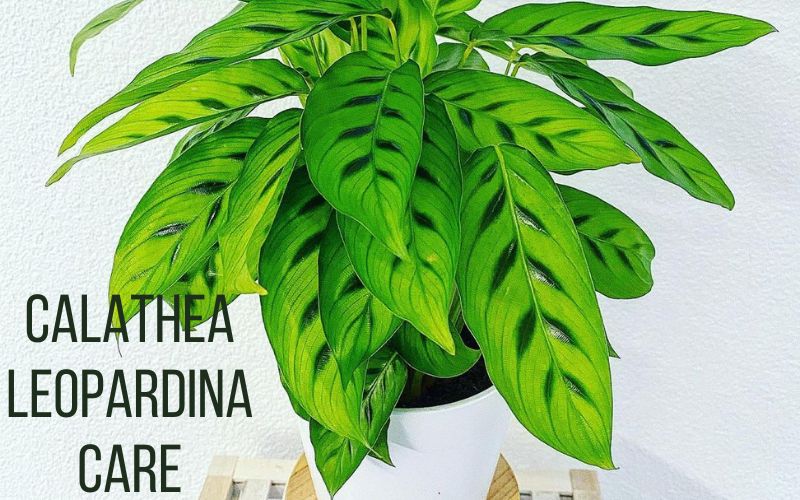Adding a beautiful, tropical Calathea Leopardina to your place is a great pick if you’re after a houseplant that’s easy to look after and makes quite the statement. With its dark green leaves featuring vibrant stripes and awesome red bottoms, it’s the perfect showstopper–not to mention it cleans the air in your home! If you’re keen on how these plants do their thing (and what exactly they need), check out this handy guide on everything related to Calathea Leopardina care. Here we’ll go through the basics on light requirements, soil types and mixtures, as well as watering tips and other top ways to look after this cool plant indoors. Keep reading for more info!
About Calathea Leopardina
Calathea Leopardina is thought to belong to the Marantaceae group. Recently, Calathea Leopardina changed her name to Calathea Concinna. Along with many other Calathea species, they’re from South America but are mostly in Brazil.
These plants, like most of the Calatheas, follow a day-night cycle, which means their leaves open in the morning and close in the evening. Calathea Leopardina is popularly known as the Prayer Plant.
The height range of Calathea Leopardina is 12 to 24 inches (30-60 cm). The long or egg-shaped leaves can reach a length of 18 inches (45 cm). They have deep green skin and purple spots like a leopard.
Calathea plants come in over 300 different types, many of which are mixes grown in labs. They don’t need a lot of fuss to do well. Calatheas have evolved to handle hot, humid weather of rainforests.
People who sell plants often mix up Calathea Leopardina with Calathea Freddie. While Calathea Freddie shows off white flowers, Calathea Leopardina grows yellow flowers out in nature.
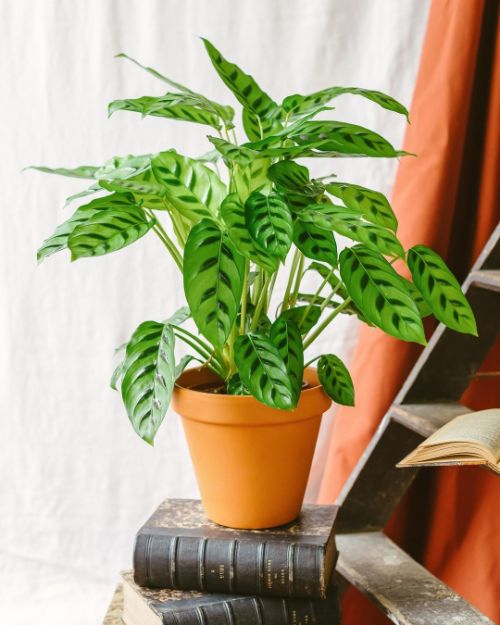
Calathea Leopardina care overview
| Botanical name | Goeppertia Concinna |
| Common Name | Calathea Leopardina, Calathea Concinna, Maranta Leopardina, Shadow plant |
| Family | Marantaceae. |
| Origin | Tropical Latin America |
| Flower Color | White |
| Height | 2 Feet |
| Soil | a rich, well-draining soil |
| Water | when the top inch of soil is dry |
| Humidity | high humidity |
| Temperature | 70 – 85° F |
| Sunlight | bright, indirect light |
| Fertilizer | every 4-6 weeks during the growing season |
| Pests and Diseases | mealybugs, spider mites, and root rot |
| Toxicity | not toxic |
Calathea Leopardina Care Tips
Light Requirements
Calathea Leopardina is a tropical plant native to Brazil and so, it needs some good light but nothing too direct. The plant is pretty tough too, okay with lots of different types of light. The light requirements for your calathea from the sun or from fluorescent bulbs is ideal for this species as it keeps its leaves looking bright and lively.
Place your Calathea Leopardina in an east-facing window for optimal light exposure. But don’t let it get too much sun, it’ll burn the leaves. If you don’t have a window that faces east, maybe get one of those special plant lights that you can move around your home as needed.
You have to keep a close watch on the leaves to make sure it’s not getting too much or not enough light. Move your plant if it’s getting too much light or if calathea leaves start to turn yellow. If it’s not growing well or the leaves are getting pale, your plant needs more light, so move it somewhere brighter pronto.
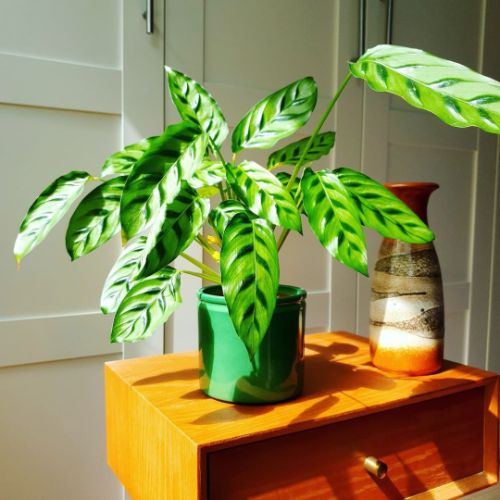
Soil
Soil’s pretty important for taking care of this plant. You gotta put it in a mix that drains well, consisting of roughly
- 1/3 organic material,
- 1/3 sand
- 1/3 substrate such as perlite.
This mix lets you manage the water, which helps your plant grow healthy. Additionally, a light fertilizer should be applied once per month to make sure it’s getting all the stuff it needs to be super healthy. Making sure these two things are balanced will really help your plant keep doing its thing.
Watering for Calathea Leopardina
When it comes to watering Calathea Leopardina, it’s all about finding the right balance. Water it once a week if it’s warm but not too dry. You should water it less in winter. And in summer, it can need water every 3–4 days. Check the soil first before adding more water every 5-6 days.
Water your Calathea plant when the top bit of soil feels dry but not bone dry. Give it a good water and make sure the extra water can get out of the pot. Empty any extra water that’s in a saucer or tray under the pot. Watering your Calathea too much can lead to root rot, and not enough water will make the leaves wilt.
Water with lukewarm or room temperature water as cold water can shock it. It’s best to test the soil before watering by feeling it with your finger or using a gadget. It’s better to water it with distilled or rainwater. As tap water can contain salts and minerals that could be damaging to your Calathea.
Finally, don’t get the leaves wet when you water, it can make them go brown. Watering in the morning will also help reduce the number of pests that may be attracted to a humid night-time environment.

Temperature requirements
The best temperature for Calathea Leopardina is between 65-85°F (18-30°C). This range copies the usual surroundings of its native tropical home, providing the plant with the necessary warmth to thrive. However, it’s important to maintain the temperature consistent, as quick changes can stress the plant and make it more prone to sickness. Calathea Leopardina is sensitive to sudden temperature changes and cannot adjust well to extreme variations in its environment.
Try to avoid temperature changes as much as you can. For instance, don’t put your Calathea Leopardina near sources of hot or cold drafts, like open windows, vents, heaters, or air conditioners. These drafts can cause a quick drop or rise in temperature, which can be bad for the plant’s health. It’s best to keep the Shadow Plant away from these sources to make sure it has a steady temperature surrounding.
During the winter months, it’s crucial to keep a close eye on the temperature, as a cold draft or even sitting near an open window can cause a sudden drop in temperature that can hurt your Calathea. Keeping your Calathea Leopardina in a warm and consistent environment will make sure it stays healthy and vibrant for years to come.
It’s important not to let temperatures fall below 60°F (15°C) as these can cause serious damage to the plant. Exposing Calathea Leopardina to temperatures below this level can result in hindered growth, sudden heat change, and potentially even the death of the plant. Maintaining a consistent temperature within the recommended range will help prevent these adverse effects and ensure optimal growth and development.
Ideal humidity
The ideal humidity for Calathea Leopardina is over 80% relative humidity.
Make the air more humid around your plants if you notice that the leaves are becoming slightly crunchy and dry.
There are several methods to increase the moisture in your home:
Using a humidifier is the easiest and most cheap method to increase your home’s relative humidity. This device adds moisture to the air by releasing a cool mist which helps to increase the humidity level for your Calathea. You can also place pots of water near your Calathea plants or use a pebble tray filled with water.
You can spray the leaves every few days with distilled or filtered water. The foliage of your Calathea Leopardina should be kept clean by wiping off any gathered dust.
Finally, you can group plants together to create a small jungle vibe and keep them in bathrooms where there is naturally more moisture.
By taking these steps you can provide the perfect surroundings for your Calathea Leopardina.
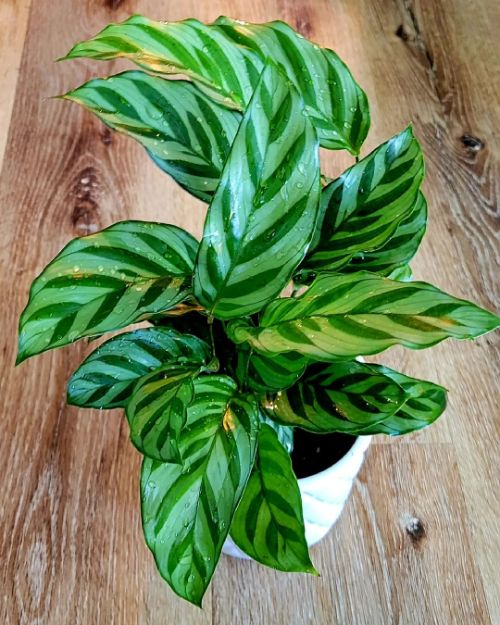
Pruning
Pruning helps new growth and helps keep Calathea Leopardina looking its best by removing old, dying leaves and stems. Prune once every few months or whenever you notice dead or leaves turning yellow.
Pruning should be done carefully, considering the natural shape of the plant. Start at the tips of the leaves, working your way down to the base. Use sharp, clean scissors or shears, and cut back only to the healthy part. Prune enough foliage so that light can reach lower parts of the plant and help encourage new growth.
Remember to always use clean, sharp cutting tools when pruning, and be sure to discard any trimmings from the plant immediately to stop diseases or bug attacks. Pruning should be done sparingly and with care, as too much can damage the plant’s health.
Pruning is a simple task but it goes a long way in helping your Calathea Leopardina stay healthy and vibrant.
Fertilizing
Fertilizing is a crucial bit of caring for Calathea Leopardina plants. During the growing season, which generally runs from spring to summer, it’s best to fertilize every 4-6 weeks with a diluted fertilizer solution.
Plant food helps provide necessary nutrients to the plant and can help encourage healthy growth. When choosing a plant food to use, look for one that is specifically for houseplants and contains an even blend of nitrogen, phosphorus, and potassium. Avoid over-fertilizing as this can harm the plant.
When winter comes around, it’s best not to fertilize at all. This is because the plant slows down its growth during this season, so fertilizer isn’t necessary. Fertilizing during winter can cause more harm than good, so it’s best to avoid it all together.
Repotting a Calathea Leopardina
Repotting a Calathea Leopardina is a fairly straightforward process that you can wrap up in just a few steps:
- Start soaking the soil thoroughly, making sure it’s fully waterlogged.
- Once the soil has been properly soaked, it’s time to take the plant out of its old pot.
- Gently get rid of extra soil from the roots and take out the root ball from the container.
- Place the root ball in a new container slightly larger than the previous one, fill it with fresh potting soil, and then lightly press down to give an even surface.
- Finally, water the new soil thoroughly so it’s damp all over.
Repotting should be done during the early spring or the middle of summer for the best growth. If your Leopardina grows regularly, you’ll probably need to repot it once every two to three years.
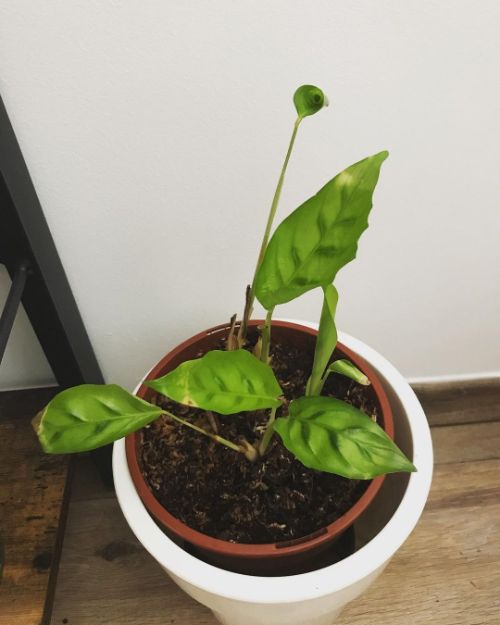
Calathea Leopardina Propagation
Propagation of the Calathea Leopardina is best done when repotting your plant. Like most varieties of Calathea, the Leopardina can be propagated by division. To divide the plant:
- Gently remove it from its pot, and separate the rhizome into two or three sections with a sharp pair of scissors or a gardening knife.
- Make sure to leave at least one healthy leaf in each division.
- After separating the rhizome, re-pot the divided plants into separate pots using potting soil that drains good and has plenty of organic stuff.
- Water the newly propagated plants thoroughly and keep them away from strong light for the first few weeks to help them settle in.
- After a month, gradually increase water and light exposure until they reach their normal levels.
With good care and watering, each of your plants can thrive.
Calathea Leopardina Care Common Pests, Disease & Common Problems
Common Pests
Like many other indoor plants, Calathea Leopardina is prone to bugs that can harm its leaves and slow its growth. The following are some usual bugs that could harm Calathea leopardina:
- Spider mites on calathea: These microscopic parasites leave yellow or brown stains on the calathea leaves and can be known by their webs. Keep the humidity high near the plant and constantly clean its leaves to avoid spider mites.
- Mealybugs are fuzzy, white insects that feed on plant sap, weakening the plant over time. They can be eliminated by spraying the plant with insecticidal detergent or wiping the leaves with a cotton swab dipped in rubbing alcohol.
- Scale insects are tough, brown or black insects that cling to the leaves and stems of the plant and scavenge its sap. You can get rid of them by spraying the plant with insecticidal detergent or with a cotton swab dipped in rubbing alcohol.
- Fungal gnats: These little black insects feed on the roots of the plant, which can slow the plant’s growth. By giving the plant less water and selecting a soil composition that drains properly, you can control them.
It’s important to routinely check your Calathea leopardina for any signs of a bug invasion and take quick action to stop the spread. These pests can also be avoided with regular cleaning, high humidity levels, and proper watering.
Disease and common problems
Calathea Leopardina, commonly known as the “Leopard Plant,” is an attractive and popular houseplant. Unfortunately, it is also prone to certain diseases that can cause big damage if left untreated. The disease can show up in lots of ways, from yellow spots on leaves to rotten roots or fungus.
It’s important for gardeners to identify and treat any disease as quickly as possible to prevent it from spreading and causing more harm. Regularly monitoring the health of Calathea Leopardina can help gardeners catch problems early, allowing them to take appropriate action before the problem worsens.
Controlling surrounding factors like light and temperature, as well as avoiding too much water and not enough fertilizer, are also important for preventing sickness. Gardeners can ensure their Leopard Plant stays healthy and vibrant for many years by taking the necessary steps to prevent, identify, and treat disease in Calathea Leopardina.
FAQ About Calathea Leopardina Care
Q: Is Calathea Leopardina Harmful to Pets or humans?
A: No, the plant is non-toxic.
Q: How often should I water my Calathea Leopardina?
A: Water your Calathea Leopardina when the top inch of soil is dry. Generally, you’ll need to give it water 1- 2 times a week. Before watering, always check the soil moisture level as too much water can cause rotten roots and other problems.
Q: What type of potting soil should I use for my Calathea Leopardina?
A: It is best to use a well-draining, loose potting mix designed for indoor plants. Make sure the soil has plenty of organic stuff like peat moss, coconut coir, or compost in it.
Q: How often should I fertilize my Calathea Leopardina?
A: Apply a liquid fertilizer every two weeks during the growing season (spring to fall). If you are using a slow-release fertilizer, you can apply it monthly throughout the whole year.
Q: Are there any pests or diseases I should watch out for with Calathea leopardina?
A: This plant is prone to mealybugs and spider mites, so keep an eye out for these pests. If you notice any of these pests, use an insecticide according to the directions on the packaging. Additionally, watch for signs of root rot, which can occur from overwatering. Remove any affected areas and repot with fresh potting mix.
Q: What is the optimal temperature for Calathea Leopardina?
A: The perfect temperature range for Calathea Leopardina is between 70 – 85° F. It’s crucial to keep temperatures consistent – sudden changes can cause the plant to go into shock and potentially die.
With the right know-how, Calathea Leopardina makes for a beautiful and interesting houseplant that will add some life to any room. With regular water, spray, and feeding, you can keep your plant healthy and vibrant for years to come.
Check out my Calathea Leopardina Care: The Complete And Best Guide. Be sure to stick to the right care steps to keep your plant healthy and looking its best. Have you done well growing Calathea Leopardina? If you have any questions that weren’t answered here, or if you need help getting started, don’t hold back to talk to us at FamiPlants. We’re always happy to help!
Learn more about Other Calathea care resources:

